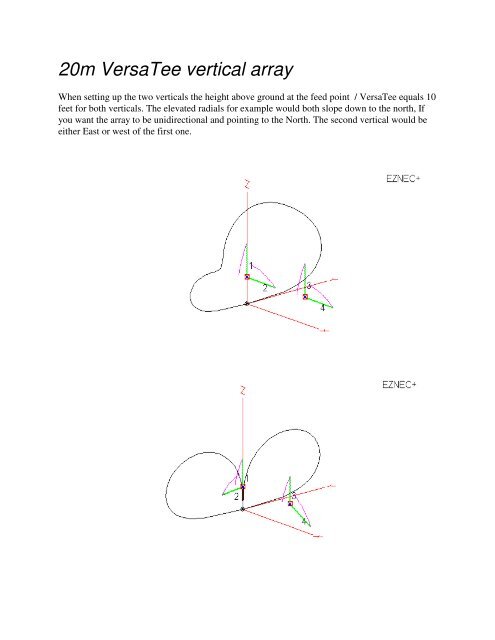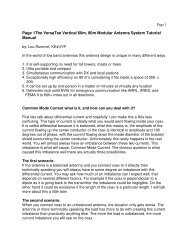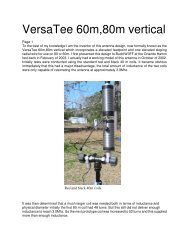You also want an ePaper? Increase the reach of your titles
YUMPU automatically turns print PDFs into web optimized ePapers that Google loves.
<strong>20m</strong> <strong>VersaTee</strong> <strong>vertical</strong> <strong>array</strong><br />
When setting up the two <strong>vertical</strong>s the height above ground at the feed point / <strong>VersaTee</strong> equals 10<br />
feet for both <strong>vertical</strong>s. The elevated radials for example would both slope down to the north, If<br />
you want the <strong>array</strong> to be unidirectional and pointing to the North. The second <strong>vertical</strong> would be<br />
either East or west of the first one.
If you want the <strong>array</strong> to be bidirectional have one radial slope down to the East and the other<br />
slope to the West. The second <strong>vertical</strong> would again be either East or west of the first one. This<br />
will create a bidirectional pattern to the north and south.<br />
When assembling the <strong>vertical</strong>s start at the <strong>VersaTee</strong> with either the red or black coil. The initial<br />
Tap Point is 4 turns from the top of the coil. This Tap Point can change depending on your<br />
location. Next you have two 22" arms and then finally the new longer whips that are 9ft. 6" long<br />
there is no improvement in efficiency raising the coil one arm above the <strong>VersaTee</strong> I have verified<br />
this using computer antenna modeling software EZNEC+5. In fact on 17m backup to 10m the<br />
gain actually goes down.<br />
So the overall length from the <strong>VersaTee</strong> to the top of the <strong>vertical</strong> measures 162" 1/2" or 13ft. 6"<br />
1/2" remember the coil adds 4 1/2" to the overall length. The elevated radials measure 16ft. 6".<br />
This is a full 1/4 wavelength on 20 m. When adjusting the antennas start with the coil if the coils<br />
that you have are three grooves take advantage of that and adjust their first. If you have the old<br />
version coils that only have one groove Set the tap Point at 4 turns from the top of the coil and<br />
make your final adjustment by lengthening or shortening the elevated radial.<br />
The angle between the <strong>vertical</strong> element and the elevated radial should equal 115 degrees. If you<br />
have the <strong>VersaTee</strong> at 10 feet above the ground, and the elevated radial is 16 feet 6" long, with the<br />
kite winder end of the wire mounted 3Ft. above ground, this will equal the required 115 degree<br />
angle between the <strong>vertical</strong> element and the elevated radial.<br />
If you have the <strong>VersaTee</strong> at 9 feet above the ground and the elevated radial is 16 feet 6" long,<br />
with the kite winder end of the wire mounted 2Ft. above ground, this will also equal the required<br />
115 degree angle between the <strong>vertical</strong> element and the elevated radial. At this height there will be<br />
a slight reduction in gain. The spacing between the <strong>vertical</strong>s equals 34ft. when connecting the<br />
coax to the <strong>vertical</strong>s I recommend using a TRSB at each <strong>vertical</strong>.<br />
The <strong>array</strong> will still work without the TRSB's but you will have some common mode current on<br />
the outside diameter of the coax braided shield. You can have any length of coax to the <strong>vertical</strong>s<br />
the only requirement is they both have to be the same length. Join the coax from each <strong>vertical</strong><br />
with a AMPHENOL-83-1 T UHF T-connector (Coax Tee) AVAILABLE at Amateur Electronic<br />
Supply and a (AMPHENOL-83-1 J- UHF (double female connector) going back to the radio<br />
with any length of coax.<br />
The input impedance at the <strong>VersaTee</strong> equals 45 ohms when the apex angle between the <strong>vertical</strong><br />
element and the elevated radial equals 115 degrees this translates to a 1.09:1 VSWR which is<br />
about as good as it gets. The 2:1 VSWR bandwidth equals 14.00Mhz to 14.350Mhz Forward
gain equals 4dBi over average ground when the <strong>array</strong> is configured for unidirectional pattern.<br />
The Forward gain equals 2.45dBi over average ground when the <strong>array</strong> is configured for<br />
bidirectional pattern.<br />
I honestly cannot think of anything else that anyone would need to know to set up this <strong>array</strong><br />
except that on 17 meters and above you do not need to use a coil just arms and the 9ft. 6" whip.<br />
On these bands each <strong>vertical</strong> is a full-size dipole 1/4 wavelength on each side.<br />
Lou KE4UYP





